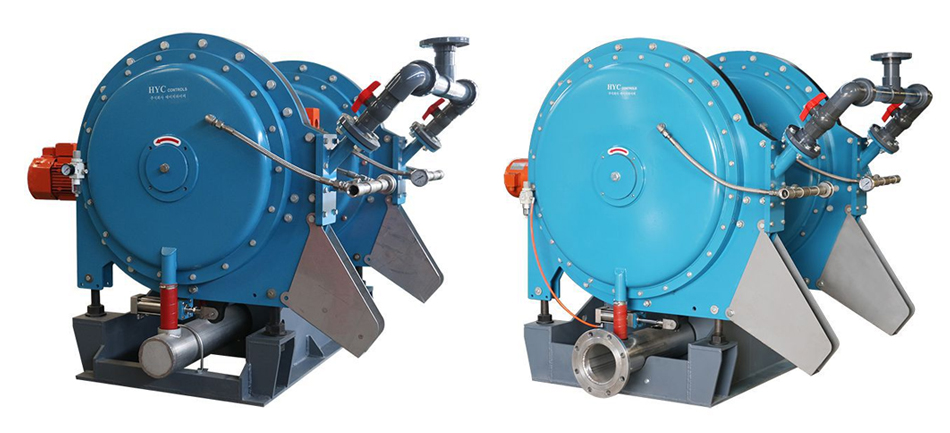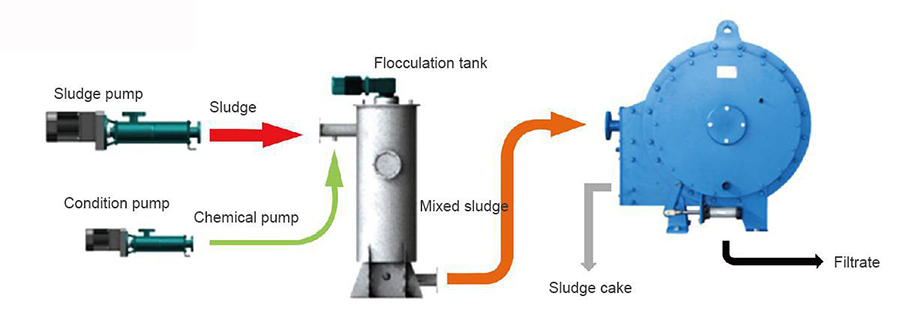Introduction
The rotary fan press is a device used in sludge dewatering treatment. This device works by applying pressure and rotating the sludge mix, thereby effectively removing liquid and resulting in a substantially reduced water content.
Field of application
Municipality, iron and steel, printing and dyeing, medical, coal washing, paper pulp, livestock manure, fruit and vegetable juice, and food waste water.

Features
· this rotary fan press is capable of accommodating a wide range of feed that has different percentage of solid content, from 0.5% to 5%.
· ensures that the water content of sludge is effectively kept between 50-80%.
· Sealed operation guarantees no foul odors, sludge, or sewage spillage, creating a pleasant working environment.
· The press body design is straightforward, with a slow rotary speed that minimizes wear and eliminates the need for any replacement parts.
· conditioning, stirring, mixing and concentrating are combined to optimize dewatering efficiency.
· Building on PLC control, this system provides a high level of automation and straightforward operation, allowing for enhanced productivity.
· Its low-speed and dependable design utilizes fewer moving components, resulting in a product that requires just 10% of the power normally used by other models.
· Ideal for smaller spaces. An easy installation and minimal land use make this an even more attractive option.
· it is possible to increase the number of filter discs, depending on your needs, by joining parts in modular fashion.
· The machine operates with a decibel level that's nearly inaudible as the rotational speed reaches around 3 r/min.
Working principle
Conditioned sewage containing sludge enters the sludge dewatering filter discs, which has an annular channel. Microporous filter plates are on either side of the disc channel, creating small holes when rotated by low speed. As a result, water is forced out of filter holes at the sides of the channel, which gradually shrinks in size. Inlet thrust and filter friction push the sludge towards the outlet, and the adjustable back pressure valve plate allows for additional water to be forced out. This fulfills the purpose of dehydration, and sludge is finally discharged from the valve plate opening.

Dewatering Process

Combination

Specifications
| Model | Channel number | Max. capacity (m³/h) | Dry sludge (DS) throughput (kg/h) | Power (kW) | |||||
| Sludge concentration (%) | |||||||||
| 0.2 | 0.5 | 1 | 2 | 2.5 | 5 | ||||
| 1 | 12 | 6 | 5 | 2.5 | 2 | 1 | 25~50 | 1.5 | |
| 2 | 24 | 12 | 10 | 5 | 4 | 2 | 50~100 | 1.5 | |
| 1 | 36 | 17 | 14 | 7 | 6 | 3 | 75~140 | 2.2 | |
| 2 | 72 | 34 | 28 | 14 | 12 | 6 | 120~280 | 2.2 | |
| 4 | 144 | 68 | 56 | 28 | 24 | 12 | 280~560 | 2.2 | |
| 1 | 60 | 28 | 24 | 12 | 10 | 5 | 110~240 | 4.0 | |
| 2 | 120 | 56 | 48 | 24 | 20 | 10 | 220~480 | 5.5 | |
| 4 | 240 | 112 | 96 | 48 | 40 | 20 | 440~960 | 5.5 | |
Sludge characteristics, concentration, flocculation and environmental conditions will have an impact on the treatment capacity and dehydration rate. The data in the table are the experimental results of the sample sludge, which are only for reference of equipment selection. For other technical parameters, please consult Xuyang for details.